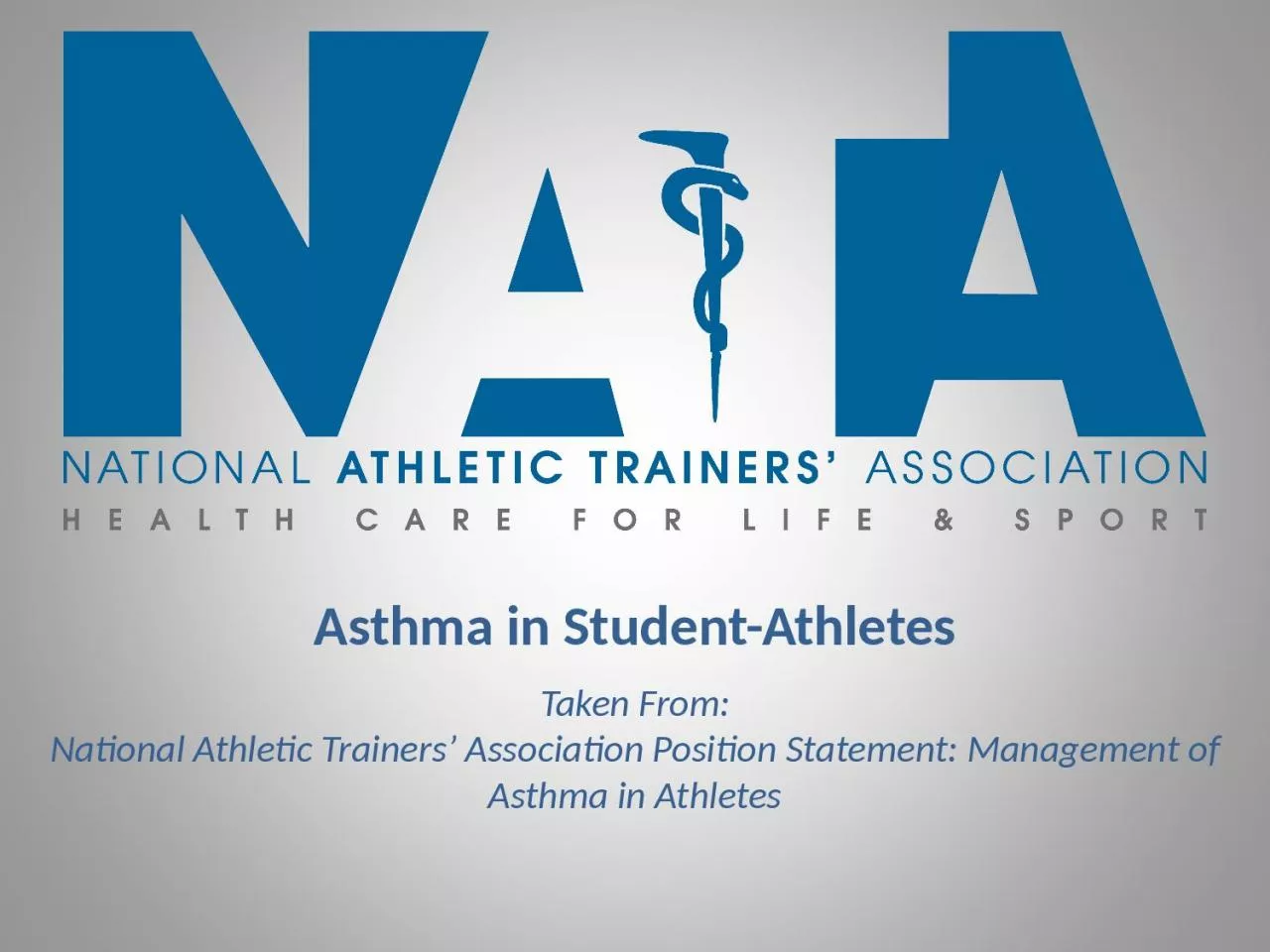

Taken From National Athletic Trainers Association Position Statement Management of Asthma in Athletes Asthma A chronic inflammatory disorder of the airways characterized by variable airway obstruction ID: 1009036
Download Presentation The PPT/PDF document "Asthma in Student-Athletes" is the property of its rightful owner. Permission is granted to download and print the materials on this web site for personal, non-commercial use only, and to display it on your personal computer provided you do not modify the materials and that you retain all copyright notices contained in the materials. By downloading content from our website, you accept the terms of this agreement.
1. Asthma in Student-AthletesTaken From:National Athletic Trainers’ Association Position Statement: Management of Asthma in Athletes
2. AsthmaA chronic inflammatory disorder of the airways characterized by variable airway obstructionCan lead to recurrent episodes of wheezing, breathlessness, chest tightness, and coughing; particularly at night or early morningAirflow limitations are often reversible, but as asthma symptoms continue, patients may develop “airway remodeling” that leads to chronic irreversible airway obstructionSevere attacks of asthma can also cause irreversible airflow obstruction that can lead to death
3. Asthma TriggersAsthma can be triggered by many stimuli, including:Allergens (pollen, dust mites, animal dander)Pollutants (carbon dioxide, smoke, ozone)Respiratory InfectionsAspirinNSAIDSInhaled Irritants (cigarette smoke, household cleaning fumes, chlorine)Particulate Exposure (ambient air pollutants)Exposure to ColdExposure to Exercise
4. Asthma Signs and SymptomsAnxious appearanceSweating and palenessFlared nostrilsWheezing and irregular breathing (especially on exhalation)Chest tightness and/or painNight coughCoughing for no apparent reasonExcessive throat clearing and yellow, green sputum is dischargedFast breathing and rapid heart rateIncreased workload leads to rapid onset of fatigueHunched over body postureVomitingTingling and numbness in hands and feet
5. Asthma ConsiderationsAll athletes with asthma should have a rescue inhaler available during games and practicesAthletic trainers should also have an extra rescue inhaler for each athlete to administer during emergenciesAthletes with asthma should have asthma management examinations at regular intervals, as determined by the PCP or specialist; to monitor and possibly alter therapyProper warm-up before exercise may lead to a refractory period of as long as 2 hours, which may results in decreased reliance on medications by some athletes with asthma
6. Exercise Induced Asthma (EIA)A temporary narrowing of the airways induced by exercise in which the patient has asthma symptomsEIA is commonly seen in athletes in all levels of athletic competitionEIA can occur in patients who do not otherwise have asthmaFactors contributing to EIA include air conditions (ex. cold air, low humidity, pollutants, allergens)/ duration, type and intensity of exercise/ poor physical conditioning/ respiratory infections Up to 35% of those without known asthma can be affected with EIA and 90% of diagnosed asthmatics
7. DiagnosisPhysician will perform physical exam to rule out other possible conditions, such as a respiratory infection or chronic obstructive pulmonary diseaseMedical history regarding the signs and symptoms that have been associated with breathing and exerciseLung Function TestsSpirometry- This test estimates the narrowing of your bronchial tubes by checking how much air you can exhale after a deep breath and how fast you can breath outPeak Flow- A simple device used to measure how hard you can breathe outLung function tests are often done before and after taking a medication to open your airways called a bronchodilator, such as albuterol
8. National Asthma Education and Prevention Program IITreatment of Exercise Induced AsthmaOne goal of management is to enable patients to participate in any activity they choose without experiencing asthma symptomsExercise-induced bronchospasm (EIB) should not limit either participation or success in vigorous activitiesRecommended Treatments for EIB include:Beta2-agonists will limit EIB in more than 80 percent of patientsShort acting inhaled beta2-agonists used shortly before exercise (or as close to exercise as possible) may be helpful for 2 to 3 hoursOther medications may be considered as well per your asthma specialistA lengthy warm-up period before exercise may benefit patients who can tolerate continuous exercise with minimal symptoms The warm-up may preclude a need for repeated medications
9. Asthma Attack ManagementAttempt to relax and reassure the patientHave patient use rescue inhaler (Albuterol) Have patient perform controlled breathingIf an environmental factor triggering the attack, remove the patient from the areaIf these procedures do not help, immediate medical attention may be necessary
10. Asthma ConsiderationsAll athletes with asthma should have a rescue inhaler available during all games and practicesAthletic Trainers/ Coaches should also have an extra rescue inhaler for each athlete to administer during emergenciesAthletes with asthma should use their bronchodilator before exercise and take extra time to gradually warm-up prior to more intense exerciseModerate stretching and working out slowly for 15-30 minutes keeping the pulse rate below 60% maximum heart rate is recommended
11. Differential DiagnosisVocal Cord DysfunctionChronic obstructive pulmonary disease (COPD)Gastroesophageal reflux diseaseMechanical obstructions of the airway (ex. Foreign bodies, tumors)Congestive heart failure
12. Institutional Policies on Asthma ManagementInsert specific institutional policy on identification and specific asthma management methods (include medication use recommendations) and information for coaches
13. ResourcesMiller M, Weiler J, Baker R, Collins J, D’Alonzo G. National Athletic Trainers’ Association Position Statement: Management of Asthma in Athletes. Journal of Athletic Training. 2005; 40 (3): 224-245.https://www.nata.org/sites/default/files/mgmtofasthmainathletes.pdfPrentice W. Principles of Athletic Training: A Competency-Based Approach. 16th ed. 2016. McGraw Hill. Anderson M, Hall S, Martin M. Foundations of Athletic Training: Prevention, Assessment, and Management. 3rd ed. 2005. Lippincott Williams & Wilkins.